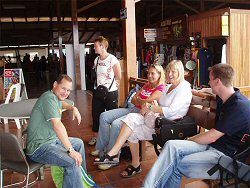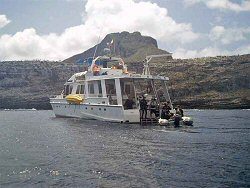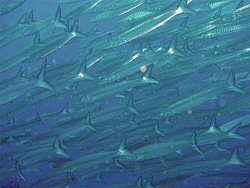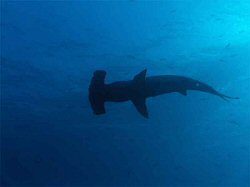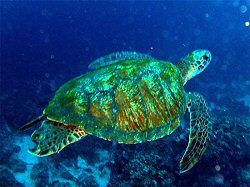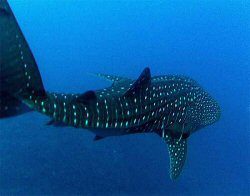Six members of Trafford Sub Aqua Club went on a liveaboard diving holiday to Galapagos in late October 2006. We were away from home for 11 nights including 7 on board the boat.
Was it expensive? Yes, very.
Was it good value? Yes.
Is it a long way to travel for only 15 dives? Yes.
Was it worth it? YES.
There are already plenty of reports about Galapagos on the BSAC travel website, including a trip at the same time we were there, so this report will not go into great detail about the dive sites or the marine life. Suffice to say that the diving is everything it is cracked up to be.
Booking and Travel
I booked the trip as a package through Dive Worldwide. As BSAC members, we each got an 8% discount. I was happy with their service, and their prices, and would use them again.
I had hoped to get a big enough group to charter a whole boat: there’s nothing better than a club liveaboard trip, where everybody knows one another. There are quite a lot of liveaboards operating in the Galapagos, but many of them are low budget operations that don’t have an established reputation for diving (not one that’s readily accessible in the UK anyway). So realistically your choice is confined to a handful of fairly upmarket boats, all of which have favourable reports on various diving websites in the US and UK: the Galapagos Aggressors, Sky Dancer, Big Blue, Lammer Law, and Mistral. In the end we booked the smallest boat, Mistral, which takes 12 divers. Even so, it wasn’t possible to find 12 people who could commit to an expensive trip 18 months ahead.
We flew with British Airways to Miami, then American Airlines to Quito, overnight in Quito, then with Icaro to San Cristobal in the Galapagos. All the flights were on time; BA and Icaro were good; AA’s aircraft were a bit scruffy and their cabin crew somewhat offhand, but I’ve had a lot worse; and there was only one baggage hassle, at Quito on the return when the AA check-in clerk insisted our baggage was overweight. It wasn’t, and after some digging in of heels and the pointless transfer of a demand valve from one bag to another, our bags were accepted. The ground arrangements were handled by Quasar Nautica, who also operate the boat. They were excellent. Overall the travel arrangements went as smoothly as any trip I can remember (that routes through LHR and the USA).
A few days before we were due to travel Dive Worldwide asked me to get each member of our party to sign a waiver for Quasar Nautica, without which we would not be allowed on board the boat. The terms of the waiver were outrageous: basically you were absolving them for any responsibility for anything at all, even if it was their fault. If you had booked direct with the operator in Ecuador you would have had no comeback at all in the event of an accident. But our contract was with Dive Worldwide, a UK company, so the waivers would make no difference to our rights in the event of a claim – a major benefit of buying a package from a UK travel agent.
Money
The package from Dive Worldwide included flights, B&B in hotels, transfers, and the all-inclusive 7 day dive trip. This cost a shade under £2500 each. Extras include park entry fees, bar bills, tips on the boat, and meals and sightseeing in Quito. This came to another £250 or so each. The currency in Ecuador is the US dollar. Credit cards are widely accepted in Quito, but you need cash as well, particularly to pay the park entrance fee (about USD100) and for tips. There are plenty of ATMs in Quito, and on San Cristobal and Santa Cruz. Strangely, the most difficult place to find an ATM was Miami airport, where a 20 minute each way walk to another terminal was required.
Large numbers of US divers use the liveaboards in Galapagos so the size of tip expected is at US levels, ie very high by European standards. The ‘guideline’ on Mistral was USD120 for the crew and USD40 for the dive guide. This was a sore point with some of the other guests on the boat, who skipped off without paying anything. I thought the crew worked hard for their tips. I have heard that the amounts expected on the larger boats is even higher, and that some tour operators are now attempting to surcharge European visitors in lieu of tipping.
The Boat
Mistral is a 23 metre twin-engined motor yacht. She has five crew plus a dive guide/naturalist. The crew were excellent. The passenger accommodation comprises 6 ensuite air conditioned double cabins, a saloon and bar, and a sun deck with seating and shade. The beds were comfortable, the air conditioning worked, the housekeeping was very good, and the saloon was well equipped with dive books, nature books and AV equipment. Meals are taken with all the guests seated around a single large table, which is sociable if a little cramped (plenty of elbow room but impossible to get in and out without disturbing your neighbours). The food was outstanding.
The dive deck is quite small, with only enough room for six to kit up at a time. This is not really a problem since each RIB only takes six, so you can kit up in two waves. The bottle racks are designed to hold a single cylinder with BCD attached, which was a bit of a problem since we had all taken our pony cylinders. It meant that some of our rigs had to be stowed on the deck. Mistral’s cylinders are all aluminium 80 cubic foot.
Weather and Conditions
The weather was warm throughout our visit. Some days were clear skies, others were overcast. There was no rain, and the wind was generally from the southeast, maximum 20 knots.
The water was warmer than expected. An El Nino had just started, which reduces upwelling of cold water from the ocean depths. At Darwin and Wolf the water temperature reached 27C, and the current was flowing south. There were occasional surges of colder water, lasting only a few seconds. At the other sites we dived it was 22-23C. Four of us wore drysuits. They were comfortable underwater (without a hood), but it was hot in the RIB on sunny days, until we learned to be last to kit up, which minimised the wait before diving.
Galapagos visit
There were eleven passengers on the boat: a Chinese couple who kept themselves to themselves; a Spanish guy; two male backpackers, one English and one Irish, who had booked a place on Mistral in San Cristobal only days earlier; and the six of us from TSAC. I had been worried about the non-diving part of the trip, whether in the presence of strangers the atmosphere might be rather subdued compared with the jollity we are used to on club holidays. As it turned out, the TSAC six had a great time, and some of the others joined in to an extent. Tortoises made from paper napkins became the icon of the trip, appearing in all sorts of unlikely places and poses. It was definitely the right move to go as a group rather than as an individual or a couple. Anne had been on Mistral several years earlier on her own, and confirmed that the social side of this one was far better.
Our trip included a visit to the outlying islands of Wolf and Darwin, renowned for their big fish action. This involves a lot of steaming: they are well over 100 nautical miles north of the main group of islands, on the other side of the equator. In total we sailed almost 600 miles in seven days. Most of the sailing was done overnight, in calm seas, a comfortable way to travel. Nobody was seasick. Every night on the boat was spent travelling or at anchor.
The package also included a series of guided land visits to see various aspects of the Galapagos wildlife and history, all of which is extensively described in books and images from Charles Darwin onwards. I won’t attempt to describe it here except to say that these are fascinating and beautiful islands, and the land visits are well worthwhile even at the expense of foregoing some diving time (at least a 24 hour layoff before departure is advisable anyway before a flight to Quito at 3000 metres above sea level, to minimise the risk of DCI).
The overall shape of the trip was:
* Friday. Depart UK, overnight at comfortable hotel in Quito.
* Saturday. Fly to Galapagos via Guayaquil. Good views of smoking volcanoes, and big mountains Cotopaxi and Chimborazo. Board Mistral at San Cristobal, checkout dive, sail overnight to North Seymour.
* Sunday. Dive at North Seymour, land visit to see bird life at Bachas beach, 50 mile cruise to Cousins Rock at Bartolome, second dive, then overnight to Darwin.
* Monday. Diving at Darwin Arch, at anchor overnight.
* Tuesday. Final dive at Darwin then sail down to Wolf for more dives, and exploration of sea caves in the RIBs.
* Wednesday. Two more dives at Wolf then a120 mile overnight sail back to the main group at Cape Marshall on Isabella.
* Thursday. Two dives at Cape Marshall, then a short sail to Santa Cruz for a land visit to see marine iguanas and sea lions.
* Friday. Further land visits to see giant tortoises, volcanic remains, and historical exhibits at the Darwin Centre, followed by a 60 mile sail back to San Cristobal.
* Saturday. Disembark Mistral, fly back to Quito, to same hotel.
* Sunday. Day at leisure in Quito, trip up cable car for excellent views of city, and walk up hillside to 4300 metres.
* Monday. Return to UK via Miami, arriving Tuesday morning.
The Diving
Galapagos underwater has featured in so many nature documentaries and trip reports that there is nothing I can add about the marine life that hasn’t been described better elsewhere. Suffice to say that we saw everything on our list and more, in large quantities: hammerheads, Galapagos sharks, white tips, whale shark, turtles, dolphins, sea lions, manta rays, eagle rays, big tuna, massive schools of fish, etc, etc. Darwin and Wolf are outstanding, yet my best dive of all was the last one of the trip, at Coca Bay on San Isabella. We saw sea lions feeding on a huge shoal of barracuda, tuna feeding on another big shoal, a manta ray, and three mola-mola. Without a doubt Galapagos was the best big fish diving I’ve ever done, in 2000 dives. Even the checkout dive was exceptional.
Some comments on the style of diving may be useful. A liveaboard cruise here is not for most beginners or occasional divers I’d say. The vis is pretty good; it’s warm; and nothing we did was terribly deep (<30m) typically on a boulder slope or shallow reef – no big Norway or Cayman style walls. But, the very best dives are in current-swept areas, and the style is that you go down and hang on to the rocks and watch the life swim past. The current was 2-3kn, with occasional stronger gusts, enough to tug at your mask, etc. It’s not the usual floaty sort of diving: it’s more physical and in-your-face (literally), so everybody needs confidence and/or bottle.
The dives generally ended with a drift out into the blue. Our photographer found her big new camera a bit of a handful on some of the dives (a reef-hook might have come in handy). People with small cameras and videos that could be held in one hand got just as good shots. You’d certainly want to be at a standard where basic skills like buoyancy, mask clearing, monitoring gas consumption, etc are second nature. The dive companies set some minimum standards, 50-100 dives, 30 dives in the last year, that sort of thing. I didn’t notice exactly since all our group was way over it, but having been there it doesn’t seem an unreasonable stipulation. The diving here is sometimes described as challenging: I’d say yes it is, but for an experienced BSAC club diver, not very.
All the dives bar one were made from Mistral’s two RIBs. The boathandlers were excellent; the boarding and disembarking procedure was slick (there was a metre or so of swell out at Darwin, so you need to be reasonably agile – this would apply to any dive boat out there); and both boats stayed in touch with each other and Mistral by radio. The boats were always there immediately you surfaced. Darwin and Wolf in particular would be very bad places to lose contact with your boat so the boat supplies safety sausages and air horns for each diver. However we all preferred our own delayed SMBs, which we sent up as soon as we started the drift at the end of every dive. The air horns wouldn’t fit the couplings on most of our group’s equipment (Apex and Buddy), but fortunately most of us had our own anyway. It’s always best to take your own equipment, including a variety of surface detection aids.
Galapagos National Park regulations require that all land and underwater visits are guided. As I understand it, this is primarily for the protection of the environment rather than the nannying of visitors. Our guide was well-educated, knowledgeable, and spoke reasonably good English. He added a lot to the land visits; his choice of dives sites was impeccable; his dive briefings were clear and topographically accurate; and we would not have seen a whale shark without him.
I was less happy with him as a dive guide. In fairness I should state that I dislike guided dives. I do not require assistance with navigation or any other diving skill, and I enjoy exploring and taking responsibility for my own safety. However, I accepted that in order to dive the Galapagos we would have to dive in a group following a dive guide. Unfortunately ours proved difficult to follow without spending the entire dive concentrating on him rather than the wildlife. He took a video camera on every dive, and in my opinion spent too much time chasing shots and not enough keeping in touch with the group. (He sold a DVD of his edited footage at the end of the trip. It was quite good.) The worst example occurred at Cousins Rock, an easy site, where there was an immense and beautiful shoal of fish with which, left to my own devices, I would have spent the entire dive. He disappeared into the shoal, ignored the dive plan in respect of depth, and we spent most of the dive looking for him, unsuccessfully. I was fuming afterwards. Later at dinner he asked the entire group if we had had a good dive. Big mistake. After that we made less effort to keep in touch. It seemed that the best way to deal with the situation was to listen carefully to the dive brief, follow the overall plan especially with regard to the pickup point, then do your own thing within those constraints.
We had one amusing experience with the currents. We were diving next to a pinnacle at the north end of Wolf, where there was quite a strong current. At the end of the dive Jen and her buddy let go and drifted off into the channel between Wolf and a rocky outlier to the north. My buddy Rachael and I followed and I saw Jen’s DSMB going up. A couple of minutes later I noticed that her delayed was back next to her, deflated. A down current had pushed it through a big circle, turned it upside down, emptied the gas out of it, and tied a knot in the line!
Summary
Galapagos is a long way, and it’s expensive, but it’s worth it even for a seven day dive trip. Darwin and Wolf are a must, but everywhere is good. The land visits are excellent as well. Take your own equipment. Going with a group of people you know makes the social side of the trip much better. I would use both Mistral and Dive Worldwide again.
Richard Scarsbrook – BSAC First Class Diver/Advanced Instructor, RYA/MCA Coastal Skipper.

